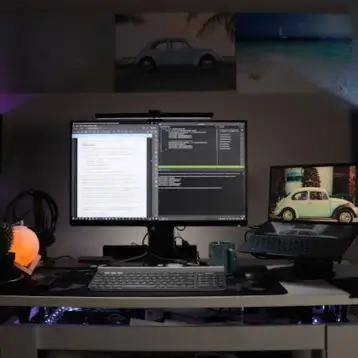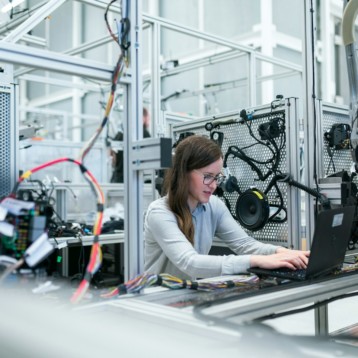|
In late 2003, a small company from the San Francisco Bay Area demonstrated a unique revolutionary display technology. The (then) prototype device projected an image in thin air just above it, creating an illusion of a floating hologram, reminiscent of the famous scene from ‘Star Wars’ in which R2-D2 projects a hologram of Princess Leia.
The development of this distinctive technology, dubbed Heliodisplay by its developer Chad Dyner, began early this decade after Dyner decided to trade a promising career as an architect to become an inventor. Dyner bought an ordinary digital projector, took it apart, and spent entire days trying to figure out a way to stop in midair the light coming from the projector without engaging a traditional screen. Though the details are kept a closely-guarded secret, Dyner was willing to provide a general description of the way the Heliodisplay works.
|
Displaying an image using conventional projectors requires a non-transparent medium, typically screens, walls, or even water, but air, which is transparent, cannot be used. A more recent development is the FogScreen, which creates an image in midair by employing a large, non-turbulent airflow to protect the dry fog generated within from turbulence. The result is a thin, stable sheet of fog, sandwiched between two layers of air, on which an image can be projected and even walked through. The Heliodisplay creates a similar effect, but, instead of fog, it uses a cloud of microscopic particles whose specific nature is one of the secrets Dyner keeps close to the vest. In 2005, the U.S. Patent Office granted Dyner a patent for a “method and system for free-space imaging display and interface“. Apparently, the Heliodisplay creates a particle cloud by passing the surrounding air through a heat pump, which in turn cools the air to a level below its dew point, where it condensates, and is then collected to create an artificial cloud. The particle cloud is composed of a vast number of individual micro droplets, between 1-10 microns in diameter, too small to be visible to the naked eye, held together by surface tension. The focus and illumination intensity of the projected image can be controlled by changing some of the cloud’s properties, enabling a sharper and brighter image.
|
Since 2003, IO2 Technology, the California-based company Dyner founded to commercialize his invention, began selling his device under the brand name Heliodisplay M2 for just under $20,000, out of reach of most consumers. IO2 Technology is actually marketing the M2 to corporate customers who would use the device as a novel way to display the company’s logo or as a strikingly impressive advertising and promotional tool for exhibitions.
|
The M2 projects its 76.2 cm (30”) diagonal floating image at a height of 71 cm (28″) above the projector. The native resolution of the M2 is 800 x 600 though it can support up to 1280 x 1024, and the image can be viewed from as much as a 150 degrees angle. The M2i model includes a proprietary system, called Heliocast, for interactively controlling the displayed image. A sensor inside the M2 identifies the movement of the user’s hand in the area of the projected image and the Heliocast software calculates the movement of the object projected.
TFOT recently covered another unique display technology, called Perspecta, developed by Actuality Systems. Unlike the Perspecta, which is a true 3D display capable of showing a 3D object perceived when simply walking around the display, the M2 displays a 2D image in midair, creating the illusion of depth. While the Perspecta is currently used mainly for medical and research purposes, the M2 is intended primarily for corporate use as a promotional or advertising tool at this stage. Although it is possible to view movies or play games on the M2, Dyner admitted that the current device is not intended for serious applications such as CAD (computer-aided design). The Perspecta is an enclosed device with lower resolution but with the capability to display a full 3D image and video with almost no flickering or wavering effects. A future display might incorporate the best of both worlds: an open-air display with high resolution, clear 3D capability, along with an accurate interactive capability.
To learn more about Heliodisplay technology, TFOT interviewed its inventor, IO2 Technology CEO, Chad Dyner.
|
Q: Would you explain how your Heliodisplay works?
A: The Heliodisplay transforms ambient air using a proprietary multi-stage system of modifying the optical characteristics within a planar region in which polychromatic light is scattered on this surface such that the image appears visible to the viewer. An advanced optical tracking system monitors finger movement within in the image region and is translated into cursor control movements, enabling the Heliodisplay to be utilized both as an Input & Output device in two-dimensional space. Hence I/O two technology.
Q: How much energy does the Heliodisplay projector require and is there a chance we’ll see a portable (smaller) version any time soon?
A: The Heliodisplay currently utilizes about as much energy as a larger format video projector or computer tower – 350 Watts. These specifications are available on our website. We have built smaller Helios for a select group of corporate customers for various applications and those have been as small as a lunchbox.
Q: It seems that the two main problems of the Heliodisplay technology are the contrast and the flickering. How do you plan to counter these problems?
A: Heliodisplay images do not flicker as you mentioned, but they do waver since images are projected into continuously moving air. As the current version is not intended for serious application (e.g., CAD), this is not a limitation. We are, though, working on improving the quality and the current version, which has already delivered results superior to the previous systems.
Q: Is the refresh rate fast enough to watch movies on the Heliodisplay?
A: The refresh rate is 30fps. We’ve watched the movie “The Hunt for Red October” with the US Navy. While you can watch movies, the M2 is not designed for this application as it is for corporate customers and media.
Q: Is it possible to play games on the Heliodisplay, and do you intend to introduce games that use the input technology of the Heliodisplay?
A: You can play games on the Heliodisplay, but the picture quality would work for only certain types of games today. This is not to say that with a future version this would not be more widely adopted.
|
Q: In the 2005 patent application you suggest the concept of two separate Heliodisplays that project images to two different viewers (a concept similar to that shown in the 1983 James Bond film “Never Say Never Again”). Are you working on such a solution or some other gaming/arcade model?
A: We have various technologies, some of which are publicly available in patents, others which are not disclosed. We have a military section, for example, in which we do not disseminate anything other than our contact. We have been requested to build a dual-viewing Heliodisplay as in the James Bond movie you are referring to, but yet to have a client who absolutely needs this to go ahead.
Q: Another concept mentioned in the 2005 patent was the cell phone-sized Heliodisplay. When do you predict such a technology to become commercially available?
A: There is no estimate for this. I would say at least a decade, maybe more, and it would probably not be using the current system that is commercialized today.
Q: What is the status of the product and what is its present price range?
Q: What do you see as the Heliodisplay’s biggest potential market and what do you think of the product for the end user/home market?
A: The M2 is intended for corporate customers, not for home use. However, IO2 has sold a few Helios to an undisclosed number of high net-worth individuals.

















